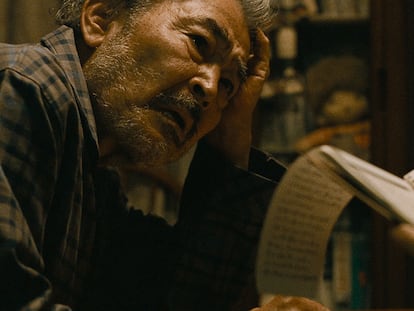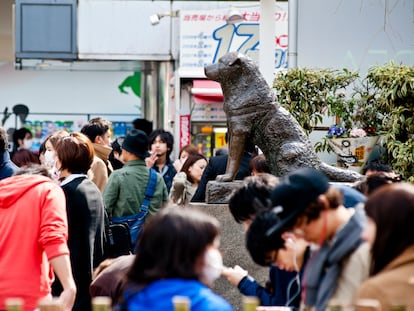The tower that ended loneliness in Japan: A sociological experiment with 43 people between 8 and 92 years old
The Nagaya Tower, in the city of Kagoshima, is a peculiar six-story structure. It is part of a research project on mutual support between the young and the old
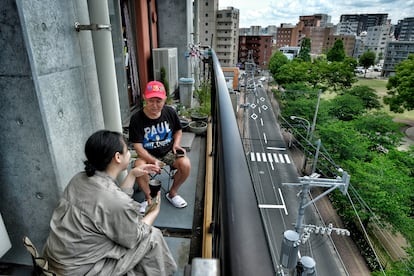
A couple paddle leisurely down the Kotsuki River on an orange kayak in the peaceful city of Kagoshima, located on the southern Japanese island of Kyūshū. In the background, Sakurajima, one of Japan’s most active volcanoes and symbol of the city, smokes lightly. This could be an ordinary scene in the landscape of this city of nearly 600,000 inhabitants, were it not for the fact that the two rowers are more than 40 years apart in age. They are part of a peculiar community located just a few meters from the river. Masatoshi, 80, was the first to move into Nagaya Tower a decade ago, while Hidaka, 38, his companion on today’s kayak trip, is a recent arrival in this community. The Tower’s 43 residents, between the ages of 8 and 92, live in rental apartments in the six-story building.
“This neighborhood is inspired by the old nagayas of the Japanese Edo period, which more than 150 years ago were part of a collective lifestyle. From children to the elderly, families and bachelors of different occupations, everyone lived together in the same compartmentalized longhouse, and around the common well they would chat while doing laundry or household chores,” explains Yasunori, 72, who joined this project five years ago with his wife, Mutsuko, 70. “Nagaya Tower is a modern tenement house, a community that values residents’ bonds. Plus, the owner is a doctor at the hospital next door, which is reassuring for the older residents,” he adds as he pulls weeds with his wife and a couple of children from the Muffin Child Development Support Office, located on the second floor of the building. The center for children with developmental disabilities is also part of the tower project. It organizes activities with the residents as part of its educational program, enriching both the younger children and the older ones who spend time with them. “The children learn rules and manners through interaction with other elders who are not members of their immediate family, developing communication skills,” says Nobuhisa, 39, who is in charge of the center.
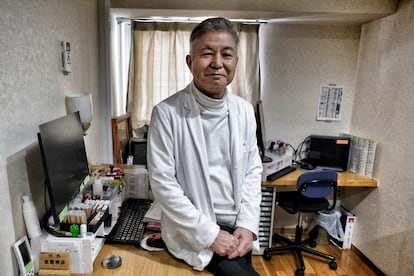
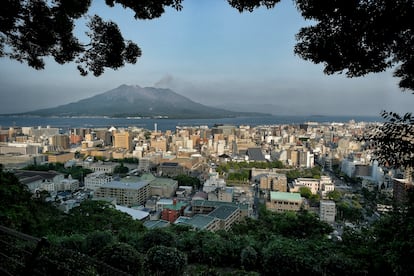
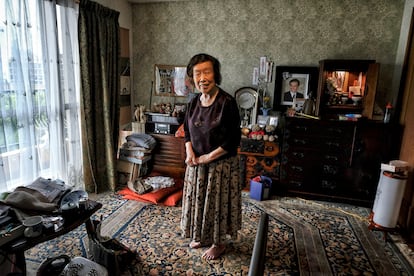
The project is based on the vision of Dr. Haruhiko Dozono, 71. At the age of 43, Dozono founded one of Japan’s first palliative care clinics, where he realized that most of his mentally impaired patients suffered from social isolation and psychological loneliness. He believed that what they needed was not medication but human interaction. He was aware, though, that there were few places where they could have those connections. So he decided to create a space where older people could be part of a community. In 2011 he applied for a grant from the Ministry of Land, Infrastructure, Transport and Tourism with his Nagaya Tower project: a building where different generations could meet, with shared community spaces and facilities, and with staff dedicated to creating community life in order to combat the loneliness of the elderly, which has become a significant problem in an aging Japanese society.
After his proposal was approved, construction of the complex began and was completed in March 2013. “It was the first intergenerational living project in Japan,” says the doctor proudly, “and I am happy to see that little by little this model of community living that fosters relationships between different generations is being replicated in other cities.” Some of the residents are his patients. Since they have been living in a community, their mood has improved and, with it, their health. “In this country, there are more and more elderly people who are alone,” says Dr. Dozono, listing in the same sentence two of Japan’s biggest problems today, “and Nagaya Tower aims to combat this major problem.”
According to United Nations data, in 2021 Japan had the oldest population in the world: 29.8% of its inhabitants were 65 years old or older, and it is estimated that the percentage will reach 37.5% in 2050. Loneliness is a major concern in the country, so much so that in 2021, the Japanese Cabinet Office appointed a Minister for Loneliness and Social Isolation. A survey by Japan’s National Institute of Population and Social Security Research conducted in 2017 revealed that 15% of older men living alone talk to one person or fewer every 15 days, while 30% feel they have no reliable people they can turn to for help.
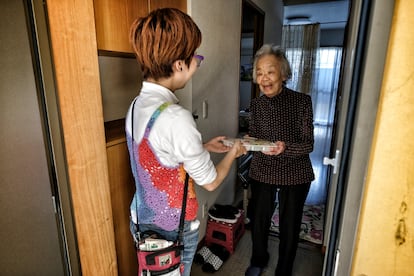
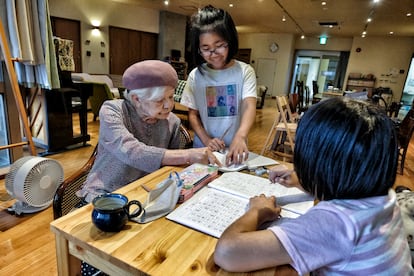
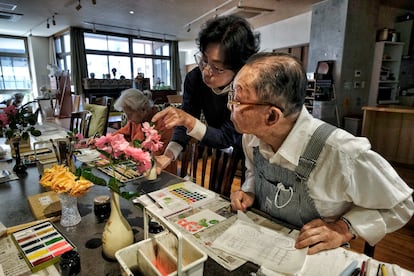
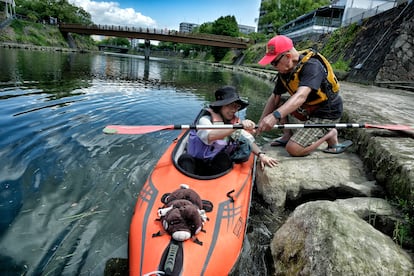
The next morning, as he does every Monday, Yasunori meets Kaneko, 92, and Yamamoto, 85, in the second-floor living room to practice music. “I’m learning to play the harmonica,” Yamamoto laughs. She decided to move to Nagaya Tower three years ago, when she became a widow, to have more company. She is starting to experience dementia, and she needs to write down everything she has to do on a small blackboard on her front door so she won’t forget. Yasunori, sitting in front of them with his guitar, acts as a teacher. Although he confesses that he is just an amateur, Kaneko and Yamamoto follow him attentively with their harmonicas. The atmosphere is relaxed, and between songs they take the opportunity to joke and tell each other stories. Mutsuko, who has accompanied her husband, is sitting at another table doing sudoku, where she is soon joined by Tamaoki, a 70-year-old neighbor who has been in the community for a decade.
Residents come to Nagaya Tower because they want to be in a community and at the same time have their own space. “When someone new wants to live here, we make sure to explain the philosophy of this place and encourage residents to interact and help each other,” Asahi explains during his daily rounds, where he checks that older residents are doing well and have taken their medication.
Asahi, 32, and Tomoru, 38, are in charge of managing the building, generating community and supporting the residents’ lives. “We often see residents playing music together, chatting in the common space or in their own rooms, or helping the younger ones with their homework,” Asahi says. People over 70 pay an additional fee for life support services, and younger people can receive discounted rent if they get involved in community chores like changing light bulbs, moving furniture or taking out the garbage. The idea is that all residents help each other and don’t hesitate to ask for help when they can’t do something alone. More than 60% of the residents are over 70 years old, but there are also younger people who choose to live here to be part of a community — including a family with five girls between 8 and 17 years old — making intergenerational relationships possible.
A message on a small blackboard next to the elevator at the entrance of the building reminds us that there is a dinner at seven o’clock in the evening, in the community dining room on the second floor. The monthly activity has helped create the community of the tower today. Neighbors bring something to eat and drink, and almost everyone usually attends. From six o’clock onwards, movement begins. Little by little, residents arrive with food. Some of them start to rearrange the tables to form a single table that occupies practically the entire room. Others go to the kitchen to lend a hand to those who are cooking, and the older ones sit down where they will have dinner. “After coming to Nagaya Tower I feel rejuvenated. Nursing homes are full of old people, but here you stay young because you’re surrounded by children and young people,” says Kukita, 83, who arrived three years ago with his wife, Mikiko, 89. They had spent some time in a nursing home when he became ill, but they did not feel comfortable and decided to look for an alternative.
Kukita says he has regained his vitality and spirits. He goes for a daily walk in the park, swims in the pool, participates in the monthly art workshop and, above all, takes every opportunity to talk and spend time with the children. “Compared to other centers, at Nagaya you feel closer to life,” says Kukita as he chats animatedly with Takayoshi, 91, and Kaneko at one end of the table, waiting for the rest of the neighbors to arrive so they can start dinner. “I also decided to move here five years ago because there is such a good atmosphere, and even though I live alone I don’t feel lonely,” explains Kaneko, who recently injured her knee and finds it hard to walk, but doesn’t miss any community event that gives her a chance to socialize with others.
The neighbors catch up over the meal. Someone proposes a toast, and the younger ones get up every so often from the table, going from one side of the room to the other, spreading their joy to the older ones. “I like living alone, but not in solitude,” says Takai, 37. “That’s why I decided to live here.” Born in Fukuoka, where he lived with his parents, he came to Kagoshima when he was 29. He is one of the younger residents who most enjoys sharing his time with the seniors. “I can learn a lot from the older people through the exchange,” he says before the watchful eyes of 70-year-old Morizane, who arrived a year ago after becoming a widow. “We interact with each other through events like tonight’s dinner, and we help each other from time to time if we have any problems,” Takai says.
The building was designed in a V-shape so that everyone can see each other when they enter or leave their homes. They greet each other and chat when they pass each other, which is not a common practice elsewhere, according to Nagano, 27, who has lived here for two years. “Older people put a magnet on their front doors to let people know when they are going out so that others don’t worry if they don’t answer, and the outside balconies have no partitions, so the houses are connected and that makes it easier for neighbors to interact with each other on a day-to-day basis,” says Nagano. Masatoshi sings Bob Dylan’s Blowin’ in the Wind on the piano to a standing ovation from the audience, making it clear that Nagaya Tower’s motto, “life is happy when there are people to exchange smiles with,” is more than just a phrase.
After the applause, Masatoshi returns to his place at the table next to Hidaka. She only plans to stay for six months. She has been moving around for several years, in Japan and abroad, working as a nurse. “I read that there were many activities organized here, and I thought it would be easy to make friends. It was clear to me that I didn’t want to go to a shared space where there are only young people. Older people are much more interesting because they have more experiences, and this place seemed ideal,” explains the young nurse who has already won everyone’s favor. Masatoshi recalls that at his 80th birthday party they gave him a hat that he now wears everywhere. He loves community life and boasts about being resident zero. “I signed up before the building was finished, and I will stay here all my life,” he says proudly.
Sign up for our weekly newsletter to get more English-language news coverage from EL PAÍS USA Edition
